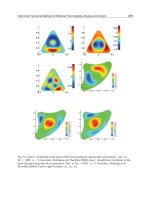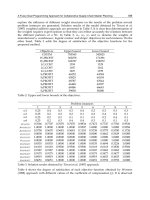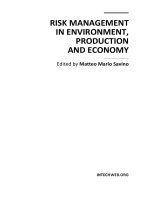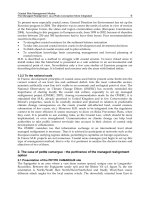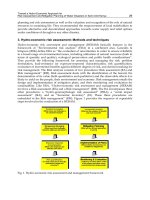Risk Management in Environment Production and Economy Part 7 pptx
Bạn đang xem bản rút gọn của tài liệu. Xem và tải ngay bản đầy đủ của tài liệu tại đây (426.36 KB, 20 trang )
Risk Analysis in the Mining Industry
109
Fig. 3. Mining project process flow chart (Mongolian case)
Scoping study
Scopin
g
stud
y
fund
Obtain exploration license
Find a territory with
bl ?
Yes
No
Exploration work
Definitive exploratio
n
Definitive feasibilit
y
stud
y
Detailed exploratio
n
Pfibl j ?
The mineral committee
assessment
Ad?
Yes
Yes
No
No
Obtain mining license
Buy a share
Government explored
territory
Mine planning
Mine Buildings
Operation
Infrastructure
Extraction Selling
Processing
3. Construction phase
Continual improvement
Investment
Rehabilitation
Closure
Investment
Environmental
monitoring
1. Exploratory
phase
Minin
g
exploratio
n
2. Planning
phase
4. Operational
phase
5. Closure phase
Risk Management in Environment, Production and Economy
110
Once all the legal aspects are in place, the company will starts it’s mine planning, including
the buildings and infrastructure that is required to be built. These set of plans are often
refered as the master plan of the mine.
3. The construction phase. The construction phase will start in accordance to the master plan
of the mine. If necessary, companies can acquire investments from an outside resource
such as financial institutions. Frequently, one of the sources for investment is to sell the
project share or bond through broker companies at the stock exchange market. Large
international investments in the mining field are regularly held in the Canadian, British
and Australian stock exchange markets.
4. The operational phase. This phase will begin under the following condition:
The main constructions for the mine, such as the enrichment factory (if necessary)
assembly, accommodation facilities for the manpower, are completed;
All machines and equipments had arrived on site;
The necessary manpower is acquired and trained.
A typical mining operation involves extraction process where the mineral is extracted from
the ground, processing of the mineral and selling. The selling process may include
transportaion to the buyer’s market.
During operational process a continious improvement is very important to lower
bottlenecks, reduce cost and increase efficiency. Furthermore, in this phase, the
rehabilitation process is intensified.
5. The closure phase. The permanent closure of a mine involves re-grading and re-
vegetation, removal and disposal of stored fuels and chemicals, structure tear down,
removal of roads and ditches, capping of tailings, waste detoxification, and
reestablishment of drainage ways (United States Environmental Protection Agency,
1997). Many features of mines such as open pits, waste dumps, and impoundments of
tailings are permanent and can degrade long after the mine has been closed, causing
further environmental damage (Miranda et. al., 2003).
3.2 Risk identification
Risk identification is a process of determining which risks may affect the project and
documenting their characteristics (PMI, 2008). Risk may be identified by understanding and
reviewing the project plans, brainstorming with and interviewing experts, looking into
previous risk related experiences and a database.
3.2.1 Literature review
Large construction projects and mining projects may share risks with similar characteristics
because both are uncertain, complicated and costly. Therefore, number of researches on
construction risks in several countries was conducted. However, no PRM study of Mongolia
has been found up to date.
Construction project risk studies conducted in countries such as Hong Kong (Shen, 1997),
Kuwait (Kartam & Kartam, 2001), Vietnam (Luu et. al., 2009), China (Fang et. al., 2004; de
Camprieu et. al., 2007), India (Ling & Hoi, 2006), United Arab Emirates (UAE) (El-Sayegh,
2007), Palestine (Enshassi & Mosa, 2008), Australia (Lyons & Skitmore, 2004) and Taiwan
(Wang et. al., 2003) was found and used to create a long-list of possible risks of the mining
projects implemented in Mongolia. Some of the risks which were considered to share a
similar effect on mining projects implemented in Mongolia were gathered in Table 1.
Risk Analysis in the Mining Industry
111
Risk description Countries of the study
Vietnam
Kuwait China Palestine UAE India Australia Hong
Kong
Taiwan
Owners’ financial difficulties 1 1 2 8 14
Owners’ unreasonably imposed tight
schedule
2
Unmanaged cash flow 30
Inadequate experience 2 23
Lack of capable and responsible site
supervisors
11 n/a
Subcontractors’ poor management 9
Shortage in manpower supply and
availability
3 7 2 3
Shortage of skills/techniques 14 3 5
Varied labor and equipment productivity 32
Lack or departure of qualified staff 9
Labor strikes and disputes 45 34
Low productivity of labor and equipment 16 6 12 20 6
Human/organizational resistance 26 41 6
Accidents during construction 23 20 3 33
Breakdown of special machinery
equipment
39 n/a
Shortage in material supply and
availability
12 10 4
Shortage in equipment availability 16 18 n/a
Late delivery of materials and equipments 28 n/a
Lack of information 4
Regulatory risks 19 n/a
Changes in laws and regulations 22 25 28 35 n/a
Government’s improper intervention 11
Corruption and bribes 23 37
Delays in approvals 8
Inclement weather 12 21 26 33 40 2
Environmental factors 24 24 n/a n/a
Table 1. List of construction project risks in various countries
The risk descriptions are listed in the left side column, and the risk rankings based on their
impact on project failure according to the literatures was positioned next to each risk.
Finally, the countries, which the risks are considered as significant during project
implementation, are noted in the second row of the table.
The list of risks in Table 1 was used as a long-list for the risk identification process in the
Mongolian mining industry. Countries in the table were chosen because they presumed to
have certain similar characteristics with Mongolia. For example, Vietnam, China, Hong
Kong, India and Taiwan are all among the developing economies in Asia and the selected
risks were considered that it has a matching impact rate in projects implemented in
Risk Management in Environment, Production and Economy
112
Mongolia. Some of the characteristics such as political instability, corruption, lack of
managers with the appropriate level of PM know-how of Mongolia are analogous with the
above mentioned countries. However, the case of Australia was used to observe the risks in
more developed counties. A number of risks were similar with the less developed countries
which can be seen in Table 1.
3.2.2 Brainstorming and interviewing
Brainstorming and interviewing was performed with mining engineers and project
managers with an experience working in Mongolia. Flow chart (Figure 3) is a very useful
tool in risk identification, as each process can be talked through with cause and effect
diagram. Based on the long-list and further discussions with experienced project managers
and researchers the following list in Table 2, of MPRs in Mongolia were selected as the most
common and significant to the project success. The risks were divided into two segments,
risks that derive from an internal and an external environment.
List of risks (internal) List of risks (external)
1 Incorrect mineral resource calculation Diesel shortage in the country
2 Owner’s financial difficulties Railway transportation delay
3 Incorrect financial resource calculation Unpredicted environmental damages
4
Not enou
g
h fund for the environmental
recovery
Boycotting
5
Unsufficient employement safety
substances
Government bureaucracy for obtaining
licenses
6 Technical problem (breakdown) Pressure from the government inspectors
7
Shortage of skilled manpower for the
mining machinery
Changes in laws and regulations (negative
effect case only)
8
Unsufficient skills of the project
managers
Price fluctuation of minerals (negative effect
case only)
9
Accidents during construction and
operation
Foreign exchange rate fluctuation (negative
effect case only)
10 Poor management Shortage of experts
11 Irresponsibility of the workers Shortage of local manpower
12 Shortage of equipments Poor infrastructure
13 Poor internal communication Demand fall of the mineral
14 Shortage of machinery Political instability
15 Employee strike Incrase of competition
Table 2. List of mining project risks in Mongolia
The identified risks (Table 2), were determined based on the mining industry characteristics,
as well as the country’s unique features. For example, in petroleum explorations, as
economical and technological resources are limited, managers of these companies frequently
face important decisions regarding the best allocation these scarce resources among
exploratory ventures that are characterized by substantial financial risk and geological
uncertainty (Roisenberg et. al., 2009). Uncertainty is intrinsically involved in all petroleum
venture predictions, and particularly in chance of discovery. Resource calculation is where
the mining resources are discovered during the exploration process and risk from an
Risk Analysis in the Mining Industry
113
incorrect resource calculation has a significant impact to project failure. Thus, the risk was
included in the long-list of risks created. Furhtermore, Mongolia has its own unique
characteristics because of its geographical position. The country is land locked and located
between Russia and China. Therefore, transportation of goods such as equipments and
machinery is carried by railway or trucks. The railway transportation is overly utilized and
delays occur frequently. Furthermore, a mass of diesel is consumed by mining companies
for the machineries such as bulldozers, excavators and trucks for transportation. The
country is heavily dependent on diesel import from Russia, and occasionally the supply of
diesel stops due to indefinite reasons. Thus diesel shortage is considered as a great risk of
various projects implemented in the country.
3.3 Risk analysis
To analyze the risk which were identified in the previous section, a questionnaire was
developed, to obtain perceptions of other mining project experts in Mongolia. An indication
of the relative importance of these risks in the local mining practice is given by examining
observations and judgments of those in the field. Based on employment position and work
experience, the study inferred that the respondents have adequate knowledge of the
activities associated with mining and related risks, as shown on Table 4.
1
Number of years worked in the
industry
0 – 3 years 39%
4 – 6 years 26%
7 – 9 years 15%
More than 10 years 19%
Not answered 1%
2
Knowledge of risk
management
Excellent 8%
Good 36%
Moderate 42%
A little 10%
None 3%
Not answered 1%
Table 3. Respondent’s profile
The questionnaire’s readability, lucidity and effectiveness was tested by a reveiw of the
preliminary questionnaire of two practitioners working in the mining sector of Mongolia.
Their comments were contemplated in the contents of the final questionnaire. The
Risk Management in Environment, Production and Economy
114
questionnaire forms were distributed by the senior students of the School fo Economic
Studies, National University of Mongolia. The students asked each respondent orally and
filled the form on behalf of them. In total 200 questionnaires were filled by the employees of
58 mining companies operating in Mongolia. Data analysis software SPSS 12 was used for
assessing the questionnaire data. The software made available to check the reliability of
results and the validity.
The practitioners were asked to assess the previously defined 30 risks based on their
probability of occurence and impact on projects (Table 4). Risk probability assessment
investigates the ilkelihood that each specific risk may occur. Risk impact assessment
investigates the potential effect on a project objective such as time, cost or quality.
In the left hand column of Table 4 is the list of 30 risks identified previously are ranked
based on their probability of occurence. The probability rates evaluated by the respondents
are shown in the following column. Furthermore, in the right hand column, the 30 risks
were listed according to their magnitude of impact on project success, from starting from the
most signifacant risk. The impact rate of each risk is listed in the fourth column from the left.
In the survey, respondents were asked to circle the factors using two scales with numbers
from 0 to 10. A value of 10 indicated the highest impact to project failure or probability of
occurance, while 1 indicated the lowest. Respondents had to circle numbers from 0-10 which
best indicated their opinion. The value 0 indicates that the practitioner believes that there is
no impact of the risk to project failure.
The analysis showed that the respondents perceived “Incorrect mineral resource
calculation” as the highest risk that contributed to project failure with the highes probability
of occurence. Inaccurate geological reports, drilling and assay result and magnetic works of
exploration bring high risk to mining projects. The exact geological layers and the metal
dispersion system are extremely difficult to predict. Therefore, mineral resources can be
estimated incorrectly or the average ore concentration can be inconclusive. However, the
estimated resource is the main objective for implementing the project, which is the main
income that will pay back the project investment and make profit. Thus, it is one of the most
important aspects in mining project development to calculate the resource precisely as
possible. Incorrect resource calculation reflects one of the largest contributions to a project
failure.
Furthermore, risks from the changes in laws and regulation has a high ranking in
probability of occurence due to the several changes in the Mineral law of Mongolia for the
last number of years.
Moreover, it has been revealed that a majority of project owners do not effectively plan the
financial segment of the project, which usually does not include any cost from the risk
factors that may occur during the project implementation.
According to further interview, when managers, in Mongolia, calculate the project budget,
typically include contingency amount which equals to 8 percent of the total project funds.
The contingency fund is usually spent for an alternative features along the project
implementation, and is nonexistent when the designated requisite arises. However, the
interviewed participants supposed that the project owners do realize that the industry has
exceptionally high risk, especially when the project implementation requires a lot of
investment throughout all of its phases. Thus, the following high ranking risks such as
„owner’s financial difficulty“ is apparent.
Risk Analysis in the Mining Industry
115
Risks prioritizing based on the
probability of occurance
Probability
Ranking
Impact Risks prioritizing based on the
impact on project success
Incorrect mineral resource calculation 6.15 1 7.86 Incorrect mineral resource calculation
Changes in laws and regulations
(negative effect case only)
5.76 2 6.69 Incorrect financial resource
calculation
Price fluctuation of minerals (negative
effect case only)
5.63 3 6.45 Owner’s financial difficulties
Owner’s financial difficulties 5.51 4 6.27 Diesel shortage in the country
Political instability 5.49 5 6.16 Price fluctuation of minerals (ne
g
ative
effect case only)
Technical problem (breakdown) 5.47 6 6.13 Changes in laws and regulations
(negative effect case only)
Poor infrastructure 5.44 7 5.95 Poor management
Shortage of skilled manpower for the
mining machinery
5.40 8 5.90 Technical problem (breakdown)
Foreign exchange rate fluctuation
(negative effect case only)
5.31 9 5.87 Railway transportation delay
Shortage of local manpower 5.28 10 5.86 Shortage of skilled manpower for the
mining machinery
Incorrect financial resource calculation 5.25 11 5.76 Demand fall of the mineral
Government bureaucracy for obtaining
licenses
5.18 12 5.75 Unsufficient skills of the project
managers
Shortage of equipments 5.16 13 5.70 Shortage of equipments
Unsufficient skills of the project
managers
5.16 14 5.54 Irresponsibility of the workers
Pressure from the government
inspectors
5.03 15 5.53 Shortage of machinery
Irresponsibility of the workers 4.90 16 5.43 Foreign exchange rate fluctuation
(negative effect case only)
Not enou
g
h fund for the environmental
recovery
4.88 17 5.32 Accidents during construction and
operation
Shortage of machinery 4.74 18 5.23 Government bureaucracy for
obtaining licenses
Poor management 4.71 19 5.12 Boycotting
Demand fall of the mineral 4.70 20 5.11 Unpredicted environmental damages
Poor internal communication 4.64 21 5.06 Poor infrastructure
Railway transportation delay 4.59 22 5 Not enough fund for the
environmental recovery
Unsufficient employement safety
substances
4.46 23 4.95 Political instability
Boycotting 4.41 24 4.79 Unsufficient employement safety
substances
Accidents during construction and
operation
4.39 25 4.77 Pressure from the government
inspectors
Incrase of competition 4.38 26 4.71 Employee strike
Unpredicted environmental damages 4.28 27 4.68 Poor internal communication
Diesel shortage in the country 4.18 28 4.37 Incrase of competition
Shortage of experts 4.02 29 4.13 Shortage of experts
Employee strike 3.40 30 3.91 Shortage of local manpower
Table 4. Risk probability and impact assessment
Risk Management in Environment, Production and Economy
116
3.4 Risk evaluation
To properly evaluate project risks, one must consider both the probability of risk occurrence
and the impact on project objectives once the risk event occurs. This is achieved best by
plotting the risk probability – impact matrix (El-Sayegh, 2007). The identified thirty risks
were positioned on the probability and impact matrix, as shown in Figure 4. In the matrix,
the x-axis represents the probability value while the y-axis represents the impact value.
Both scales are 1 – 10 (one being very low to 10 being very high). For a clearer view of the
figure, only scales from 3 to 7 for the x-axis and 3 to 8 for the y-axis were shown in Figure 4.
The probability and the impact values were calculated based on the average scale provided
by the respondents.
It was assumed, in this study, that if the average probability and impact of the risk is more
than five, then the risk is considered as significant wich is in need of high attention. The
matrix shows that risks within the circle of priority number 1 are the ones with highest
probability and impact. Risks in the circle of priority number 2 are the ones with high
probability but medium impact on project failure. Conversely risks in the circle of priority
number 3 are the ones with medium probability and high impact to project failure. Finally,
risks in the circle of priority number 3 are the ones with medium probability and medium
impact.
Fig. 4. Probability and impact matrix
3.5 Risk mitigation
Risk mitigation actions are adopted by practitioners to respond to various risks that threats
the project objectives. This process follows the risk evaluation process so that the risk
mitigation is concentrated on the most significant risks in the higher priority.
3
3.5
4
4.5
5
5.5
6
6.5
7
7.5
8
3 3.5 4 4.5 5 5.5 6 6.5 7
Impact
Probability
Risks priority
number 1
Risks priority
number 2
Risks priority
number 3
Risks priority
number 4
Risk Analysis in the Mining Industry
117
The final part of the survey in this study was designed to identify if the practitioners in the
Mongolian mining sector perform risk mitigation plan. The results from the survey were
shown in Figure 5.
According to Figure 5, the majority of respondents answered that they do perform risk
mitigation plan. Therefore, it can be assumed that most companies in Mongolia make an
effort to perform their risk mitigation plans.
Finally, the usage of risk management tools by practitioners in the mining industry of
Mongolia were evaluated (Figure 6). The two tools used mainly by the practitioners
Fig. 5. The performance level of a risk mitigation plan
0 10203040506070
Brainstorming
Case based approach
Check lists
Flow chart
HAZOP
Influence diagram
Questionnaires
Scenario building/Simulation
Probability and impact matrix
Probability distribution
Sensitivity analysis
Expected monetary value analysis
Risk urgency assessment
Weighted scoring model
SWOT
Cause-and-effect diagrams
Interviewing experts
Decision tree diagram
Other
Fig. 6. Usage of risk management tools
0 102030405060
Yes
Sometimes
No
No answer
57.6
34
8.4
11.6
Risk Management in Environment, Production and Economy
118
included case based apporach and brainstorming. Consistent with the results of Lyons and
Skitmores’ survey of PRM in the Queensland engineering construction industry (2004),
brainstorming was the most common technique used in risk identification. No single risk
assessment technique is best for all cases which is possibly the reason why the respondents
have opted for the simplest approach. Tools such as probability distribution and simulation
analysis were used seldom. The interview also suggested that, practitioners prefer to use
simple methods that do not take much time or effort. The quantitative risk analysis tools are
not considered to be an effective method due to various reasons such as insufficient
knowledge and experience in these analysis tools and techniques and the difficulty of
finding the true probability distribution for risks in practice. Shen (1997), in addition,
suggested that according to his survey of PRM in Hong Kong, quantitative analytical
techniques have been rarely used due to limited understanding and experience.
From this study, it is clear that the practitioners used the tools which were known to them
and the tools they considered as the most effective.
One survey respondant mentioned that a “bank performance letter” can be used as an
effective tool for reducing risk in mining project investment as it shows the company credit
reputation. For investment companies this document ensures their confidence in the mining
company. Furthermore, as mentioned earlier, financial problems are one of the major risks
of mining companies, which is a reason why the bank performance letter can be useful tool
for obtaining reliable information.
3.6 Risk learning
One of the fundamental and major steps in PRM is to identify and assess the potential risks
in the project. Every project contains some degree of risk; and yet, most project managers are
ill prepared when it comes to identifying or adequately addressing potential risks (Wang et.
al., 2004). Managers struggle to identify all the risks of projects because it is time-consuming
and counterproductive. Attempts to consider every risk are doomed to failure (El-Sayegh,
2007). The trick is to identify the most critical risks and control them (Barkley, 2004). Thus, it
is important to determine the most significant risks in the mining industry of the country
where the project is planned to be implemented.
The identification of risk and the creation of a risk list are dependent upon many factors,
such as past experience, personal tendency, and the possession of information. Therefore,
almost no two risk analysts will make the same judgment when they identify risks from the
same project (Ren, 1994).
For managers, an information database with exclusive information of the local risk
characteristics of mining projects can be argued to be effective support for mining project
managers.
3.6.1 Project risk information database
Generally, each project team performs risk management activities and retains what it learns
within the project. Thus many of the things learned from various projects need to be
reinvented in new projects (Varadharajulu & Rommel, 2008). However, finding information
of previous local projects with similar characteristics is time, effort and money consuming
and could be avoided if there is a process and mechanism by which project learning is
shared among other project managers. Consequently, an information database solution for
risk management process for information sharing among project managers is required.
Risk Analysis in the Mining Industry
119
3.6.2 Creating the project risk information database
Perhaps, previous literature, case studies and survey analysis are essential information for
creating risk database. Commonly, large projects implementation takes time and gathering
project learning and risk information from them will also take time. Therefore, in addition to
the recently implemented project learning, previous studies will contribute as a lot of
information of risk and the ways risk was managed (Figure 7). Companies which share
similar project characteristics can create a joint risk database and distribute risk information
for one another.
Fig. 7. Project risk information database
While providing inputs, a panel of specialists of the companies should review the submitted
risk information and the appropriateness. Only the generic and practical information for
future projects should be inserted.
3.6.3 Using the project risk information database
As the new project starts, project leader will go through the risk database. In order to save
time assuming the information in the database is a great deal of amount the input needs to
be categorized. The information in the database is categorized by the type of the projects
such as construction or mining project. Then the information is further categorized into
place of project implementation to find out the local risks with unique characteristics.
Subsequently, the list of literature and project learning of the required project type and
location which the project was implemented will be revealed (Figure 8). The risk database
needs to have a good guideline on the risk description and how it was managed. The
database is required to be maintained by a team appointed by the companies or the database
creator. Additionally, the information can be utilized to perform various studies such as
simulation analysis on the risk probability of occurrence and impact to project failure in the
alleged countries in the supposed types of projects.
The database will help project managers to save effort, time and money and also find out the
possible risks and understand them at an early stage. Furthermore, gathered information
can be exploited for various project risk management researches which may be helpful for
generating productive ideas and techniques that can be utilized in the modern project
management.
Previous literature
Case studies
Survey analysis
Completed pro
j
ect 1
Completed pro
j
ect N
…
Learning
Project risk information
database
New projects
Risk Management in Environment, Production and Economy
120
Fig. 8. Project Risk Information Database: Categorizing the Risks
4. Conclusion
The chapter describes risk management processes based on a study of the current views and
practices of mining projects in Mongolia. Project risks and their relative contribution to
project failure was studied. Moreover risk management tools used by those in the field were
identified. The identified 30 risks which have highest contribution to mining project failure
in Mongolia may be useful for project managers in their future project implementations and
risk management processes.
The study shows a necessity for a risk management culture in organizations in the country.
Additionally, a risk management method which is suitable for the Mongolian mining
industry which is stipulated by a research and an analytic study is required. It may be
simply impossible to predict the future of projects over a 10-15 year period of work.
However, a framework for a risk management approach that is apt for the characteristics of
the country and culture of the people can be suggested for future research.
Furthermore, creation of a risk management database will help project managers to save
effort, time and money and also find out the possible risks and understand them at an early
stage. The gathered information can be exploited for various project risk management
researches which may be helpful for generating productive ideas and techniques that can be
utilized in the modern project management.
Finally, some of the risks described in this study may also share same impact to other types
of projects implemented in Mongolia, therefore, studies in this matter is also suggested for
future researches.
5. References
Barkley, B. T. (2004). Project Risk Management, McGraw-Hill, New York, USA
Castle, G. R. (1985). Feasibility studies and other pre-project estimates: How reliable are
they?, Proceedings of the Finance for the Minerals Industry, ISBN 0895204355, New
York, February, 1985
Input from completed
projects
Pro
j
ect risk information database
User
What t
y
pe of pro
j
ect?
Where the project is going to be
implemented?
Previous literature and
experiences related to the local
risk s and projects
Risk Analysis in the Mining Industry
121
Chapman, C. (1997). Project risk analysis and management – PRAM the generic process,
International Journal of Project Management, Vol. 15, No. 5, (October 1997), pp. 273-
281
Charette, R. (2002). The state of risk management 2002: Hype or reality, Industry Report, Cutter
Consortium, Arlington, MA
Cooper, D.; Grey, S.; Raymond, G. & Walker, P. (2005). Project Risk Management Guidelines:
Managing Risk in Large Projects and Complex Procurements, John Wiley & Sons Ltd.,
England
De Camprieu, R.; Desbiens, J. & Feixue, Y. (2007). ’Cultural’ differences in project risk
perception: An empirical comparison of China and Canada. International Journal of
Project Management, Vol. 25, pp. 683-693
Del Cano, A. & de la Cruz, M. P. (2002). Integrated methodology for project risk
management, Journal of Construction Engineering and Management, Vol. 128, No. 6,
pp.473-485
Edwards, P. J. & Bowen, P. A. (2005). Risk management in project organizations, Elsevier,
Butterworth Heinemann
El-Sayegh, S. M. (2007). Risk assessment and allocation in the UAE construction industry.
International Journal of Project Management, Vol. 26, pp. 431-438
Enshassi, A. & Mosa, J. A. (2008). Risk management in building projects: owners’
perspective. The Islamic University Journal (Series of Natural Studies and Engineering),
Vol. 14, No.1, pp. 95-123
Fang, D.; Li, M.; Fong, P. S. & Shen, L. (2004). Risks in Chinese construction market –
contractors’ perspective. Journal of Construction Engineering and Management, Vol.
130, No.6, pp. 853-861
Floricel, S. & Miller, R. (2001). Strategizing for anticipated risks and turbulence in large-scale
engineering projects, International Journal of Project Management, Vol. 19, pp. 445-455
Fraser, D. C. (1984). An approach to major projects, Major Project Association, Oxford:
Templeton College Press
Gardiner, P. D. (2005). Project Management: A Strategic Planning Approach, Palgrave
Macmillan, New York
Gypton, C. (2002). How have we done? Feasibility study performance since 1980,
Engineering and Mining Journal, Vol. 302, No. 1, pp. 41-46
Jacinto, C. M. C. (2002). Discrete event simulation for the risk of development of an oil field,
Proceedings of the 2002 Winter Simulation Conference, ed. E. Yucesan, C. H. Chen, J. L.
Showdon, and J. M. Charnes, pp. 1588-1592
Kartam, N. A. & Kartam, S. A. (2001). Risk and its management in the Kuwaiti construction
industry; a contractors’ perspective. International Journal of Project Management, Vol.
19, pp. 325-335
Ling, F. Y. Y. & Hoi, L. (2006). Risks faced by Singapore firms when undertaking
construction projects in India. International Journal of Project Management, Vol. 24,
pp. 261-270
Luu, V. T.; Kim, S.; Tuan, N. V. & Ogunlana, S. O. (2009). Quantifying schedule risk in
construction projects using Bayesian belief networks. International Journal of Project
Management, Vol. 27, pp. 39-50
Risk Management in Environment, Production and Economy
122
Lyons, T. & Skitmore, M. (2004). Project risk management in the Queensland engineering
construction industry: a survey. International Journal of Project Management, Vol. 22,
No.1, pp. 51-61
Mackenzie, W. & Cusworth, N. (2007). The use and abuse of feasibility studies, Proceedings of
the Project Evaluation Conference, pp. 1-12, Melbourne
Miller, R. & Lessard, D. (2001). Understanding and managing risks in large engineering
projects, International Journal of Project Management, Vol. 19, No. 8, pp. 437-443
Miranda, M.; Burris, P.; Bincang, J. F.; Shaerman, P.; Briones, J. O.; La Vina, A. & Menard, S.
(2003). Mining critical ecosystems: Mapping the risks, World Resource Institute,
Washington DC
Noort, D. J. & Adams, C. (2006). Effective mining project management systems, Proceedings
of the International Mine Management Conference 2006, pp. 87-96
Perry, J. C. (1986). Risk management-an approach for project managers, International Journal
of Project Management, Vol. 4, No. 4, pp. 211-216
Project Management Institute, Inc., (2008) A Guide to the Project Management Body of
Knowledge: PMBOK guide – Fourth edition, Project Management Institute, Inc.,
ISBN 978-1-933890-51-7, Pennsylvania
Ren, H. (1994). Risk lifecycle and risk relationships on construction projects. International
Journal of Project Management, Vol. 12, No.2, pp. 68-74
Roisenberg, M.; Schoeninger, C. & da Silva, R. R. (2009). A hybrid fuzzy-probabilistic system
for risk analysis in petroleum exploration prospects, Expert Systems with
Applications, Vol. 36, pp. 6282-6294
Shen, L. Y. (1997). Project risk management in Hong Kong. International Journal of Project
Management, Vol. 15, No.2, pp. 101-105
United States Environmental Protection Agency (1997). Office of air and radiation, Final
report – Performance of selective catalytic reduction on coal-fired steam generating
units
Varadharajulu, M. & Rommel, C. (2008). Achieving yokoten in the process of risk
management, BPM Enterprise.com. Retrived from
Wang, M.; ASCE, M. & Chou, H. (2003). Risk allocation and risk handling of highway
projects in Taiwan. Journal of Management in Engineering, Vol. 19, No.2, pp. 60-68
Wang, S.Q.; Dulaimi, M.F. & Aguria, M.Y. (2004). Risk management framework for
construction projects in developing countries, Consturction Management Economics,
Vol. 33, No.3, pp. 237-252
Ward, S. C. & Chapman, C. (1991). Extending the use of risk analysis in project
management, International Journal of Project Management, Vol. 9, No. 2, pp. 117-123
Williams, T. (1995). A Classified Bibliography of Recent Research Relating to Project Risk
Management, European Journal of Operational Research, Vol. 85, pp. 18-38
Wyk, R.; van Bowen, P. & Akintoye, A. (2008). Project risk management practice: The case of
a South African utility company, International Journal of Project Management, Vol. 26,
pp. 149-163
Ашигт малтмалын тухай хууль, [Minerals Law] (2003). Art. 11, Par. 11.1.6-8, (Mon).
6
A Fuzzy Comprehensive Approach
for Risk Identification and Prioritization
Simultaneously in EPC Projects
R. Tavakkoli-Moghaddam
1
, S.M. Mousavi
1
and H. Hashemi
2
1
Department of Industrial Engineering, College of Engineering, University of Tehran,
2
Department of Civil Engineering, Faculty of Engineering, Zanjan University,
Iran
1. Introduction
Long lasting complicated processes and organizational features generate abundant risks in
Engineering, Procurement and Construction (EPC) projects. Iran witnesses an unprecedented
boom in engineering, procurement and construction activities at all levels with the
government’s goal of diversifying its income away from oil dependence to commercial and
industrial activities based on the fourth economical development plan. The number, size and
complexity of new EPC projects have created an extra burden on the participants and resulted
in lots of risks. It is important to identify and prioritize the important risks in Iran to help local
and international companies to consider these important risks. Hence, risk identification and
prioritization are influential factors in risk monitoring decisions (Ebrahimnejad et al., 2009).
The risk management process aims to identify and assess project risks in order to enable
them to be understood clearly and managed effectively. In fact, project risk management is a
systematic way of looking at areas of risk and consciously determining how each area
should be treated. It is a management tool that aims at identifying sources of risk and
uncertainty, determining their impact, and developing appropriate management responses
(Thomas, 2003.). There are many commonly used techniques for risk identification and
prioritization separately. These techniques generate a list of risks that often does not directly
assist the project manager in knowing where to focus risk management attention.
Qualitative assessment can help to prioritize identified risks by estimating their probability
and impact, exposing the most significant risks; this approach deals with risks one at a time
and does not consider their possible correlations, and so also does not provide an overall
understanding of the risk faced by the project as a whole (Hillson, 2002).
Project risk prioritization is usually affected by numerous factors including the human error,
data analysis and available information. The great uncertainty in projects often causes
difficulty in assessing risk factors. However, many risk assessment techniques currently
used in EPC projects are comparatively mature, such as fault tree analysis, event tree
analysis, monte carlo analysis, scenario planning, sensitivity analysis, failure mode and
effects analysis, program evaluation and review technique (Carr & Tah, 2001).
In this paper, an applicable approach in an uncertain environment that can identify and
prioritize project risks simultaneously is introduced. A decision approach is proposed that
Risk Management in Environment, Production and Economy
124
consists of three sections. In the first section, data of project potential risks are gathered. In
the second section, a group decision-making approach is used in a fuzzy environment in
order to prioritize all potential risks. In the third section, identified and non-identified risks
are separated by using an appropriate threshold concurrently. Finally, a case study in one
EPC project in Iran is conducted to illustrate the applicability of the proposed fuzzy
comprehensive approach in mega projects. Meanwhile, special attention is paid to the
various subjective analyses in the selection and prioritization process by using triangular
fuzzy numbers in an uncertain environment.
The paper is organized as follows: The related literature for mega projects is reviewed in
Section 2. In Section 3, the researchers briefly introduce some basic concepts on fuzzy sets,
including fuzzy arithmetic numbers. In Section 4, the theoretic descriptions for the fuzzy
entropy and compromise ranking (known as VIKOR) techniques are presented respectively. In
Section 4, the researchers propose the project risk identification and prioritization approach in
mega projects. Section 7 investigates a case study using the proposed model to illustrate their
potential applications in one EPC project. The discussion of results is provided in Section 6.
Finally, conclusions are offered in Section 8.
2. Literature review
The general consensus in the current literature in the field of risk management incorporates
four core steps in the process of risk management (Al-Bahar & Crandell, 1990; Ebrahimnejad
et al., 2008b; Raftery, 1999). These are:
1. Risk identification and classification
2. Risk analysis
3. Risk response
4. Risk monitoring
The second step of the project risk management process, risk analysis is to measure the
impact of the identified risks on a project. Depending on the available data, risk analysis can
be performed qualitatively or quantitatively or semi quantitatively (Alborzi et al., 2008;
Chapman, 1998, 2001; Mojtahedi et al., 2009).
The evolution of risk management in EPC projects has resulted in the development of
various risk identification and prioritization techniques. These techniques are used in
situations experiencing uncertainty in order to ease decision making regarding the project’s
future. These beneficial and practicable developments have resulted in EPC practitioners
becoming progressively aware of the importance of using these techniques at various stages
of a project to achieve a greater project success (Thevendran & Mawdesley, 2004).
Risk identification and classification is the first step of the project risk management process,
in which potential risks associated with an EPC project are identified. Numerous techniques
exist for risk identification, such as brainstorming and workshops, checklists and prompt
lists, questionnaires and interviews, Delphi groups or NGT, and various diagramming
approaches, such as cause-effect diagrams, systems dynamics, influence diagrams
(Chapman, 1998; Ebrahimnejad et al., 2008a). There is no any “best method’’ for risk
identification, and an appropriate combination of techniques should be used (Ebrahimnejad
et al., 2008a). As a result, it may be helpful to employ additional approaches to risk
identification, which were introduced specifically as broader techniques in group decision-
making field (Ebrahimnejad et al., 2010; Hashemi et al., 2011; Makui et al., 2007, 2010;
Mojtahedi et al., 2009,2010; Mousavi et al., 2011; Tavakkoli-Moghaddam et al., 2009).
A Fuzzy Comprehensive Approach for Risk
Identification and Prioritization Simultaneously in EPC Projects
125
As an integrative part of risk identification, risk classification attempts to structure the
diverse risks affecting an EPC project. Several approaches have been suggested in the
literature for classifying risks. Perry & Hayes (1985) presented a list of factors extracted from
several sources that were divided in terms of risks retainable by contractors, consultants and
clients. Combining the holistic approach of the general system theory with the discipline of
a work breakdown structure as a framework, Flanagan & Norman (1993) suggested three
ways of classifying risk: by identifying the consequence, type and impact of risk. Chapman
(2001) grouped risks into four subsets, namely environment, industry, client and project.
Shen et al. (2001) categorized them into six groups in accordance with the nature of the risks,
i.e. financial, legal, management, market, policy and political, as well as technical risks. In a
word, many ways can be used to classify the risks associated with oil and gas projects.
Mojtahedi et al. (2008) presented a group decision-making approach for identifying and
analyzing project risks concurrently. They showed that the project risk identification and
analysis can be evaluated at the same time. Moreover, they applied the proposed approach
in a mega project and rewarding results were obtained.
Insufficient information, uncertain project environment, and unique EPC projects lead to gain
some benefits from the fuzzy set theory in risk assessment. In fact, there have been limited
attempts to exploit fuzzy logic within the mega project risk management domain. Kangari
(1988) presented an integrated knowledge-based system for construction risk management
using fuzzy sets. This system, which is called Expert-Risk, performs the risk analysis in two
situations, namely before construction and during construction. Chun & Ahn (1992) proposed
the use of the fuzzy set theory to quantify the imprecision and judgmental uncertainties of
accident progression event trees. Peak et al. (1993) proposed the use of fuzzy sets for the
analysis of bidding prices for mega projects. Tah et al. (1993) tried a linguistic approach to risk
management during the tender stage for contingency allocation, using fuzzy logic. Ross &
Donald (1995) described a method for assessing risk based on fuzzy logic and similarity
measures. This approach uses linguistic variables catering for vagueness and subjectivity to
devise rules for assessing the management of hazardous waste sites. Ross & Donald (1996) also
used the fuzzy set theory for the mathematical representation of fault trees and event trees as
used in risk analysis problems. Wirba et al. (1996) used linguistic variables. This approach
considers a method, in which the probability of a risk event occurring, the level of dependence
between risks, and the severity of a risk event, is quantified using linguistic variables and
fuzzy logic. Carr & Tah (2001) presented a formal model for the construction project risk
analysis. This model involved the relationships between risk factors, risks, and their impacts
based on cause and effect diagrams. They used fuzzy approximation and composition, the
relationships between risk sources and the impacts on project performance measures.
Dikman et al. (2007) also proposed a fuzzy risk analysis for international construction
projects. This methodology utilizes the influence diagramming method and estimate a cost
overrun risk rating. Zeng et al. (2007) introduced a risk analysis model based on fuzzy
reasoning and modified Analytical Hierarchy Process (AHP) to handle the uncertainties
arising in the construction process. Makui et al. (2010) developed the concept of safety to
risk identification and assessment simultaneously in a fuzzy environment. They focused not
only on the time and cost criteria but also on the health, safety and environment critera.
Then, the NGT and MAGDM techniques were utilized for identifying and assessing risks in
a gas refinery plant construction with emphasizing the potential risk breakdown structure.
Ebrahimnejad
et al. (2009) introduced effective criteria for evaluating risks, and presented a
Risk Management in Environment, Production and Economy
126
fuzzy multiple criteria decision-making (MCDM) model for risk assessment with an
application to an onshore gas refinery. In addition, Ebrahimnejad et al. (2010) identified the
risks in build–operate–transfer power plant projects and designed a fuzzy multi–attribute
decision–making model for analyzing important risks.
Going through the literature indicates that the risk identification and prioritization problem
has not been considered concurrently in EPC projects; moreover, few studies had been
performed mega projects in Iran (Ebrahimnejad et al., 2008a; Makui et al., 2007; Mojtahedi et
al., 2008). The aim of this paper is to introduce a practical fuzzy comprehensive approach for
identifying and prioritizing project risks by applying group decision-making approach
concurrently. Moreover, fuzzy logic is used through the proposed approach because of
existing ambiguous and uncertain data in projects' environment. Finally, one EPC project as
a case study in Iran is conducted to illustrate the applicability of the proposed approach.
Meanwhile, special attention is paid to the various subjective analyses in the selection and
ranking process by using fuzzy numbers.
3. Basic definitions
In the following, a brief review of some basic definitions of fuzzy sets is presented
(Zimmermann, 1996; Chen, 2000). These basic definitions and notations are used throughout
the paper.
Definition 3.1. A fuzzy set
A
in the universe of discourse X is convex if and only if
12 12
( (1 ))min( (), ())
AAA
xx xx
(1)
for all x
1
, x
2
in X and all [0, 1]
, where min denotes the minimum operator
(Zimmermann, 1996).
Definition 3.2.
A fuzzy number is a fuzzy subset in the universe of discourse X that is both
convex and normal (Zimmermann, 1996).
Definition 3.3. A linguistic variable is a variable whose values are linguistic terms. Linguistic
terms ({not important, somewhat important, important, very important, extremely important}
have been found to be intuitively easy in expressing the
subjectiveness and/or imprecision
qualitative of a decision maker (DM)’s assessments (Zimmermann, 1996).
Definition 3.4. A fuzzy set a
in a universe of discourse x is characterized by a membership
function
a
which associates with each element x in X , a real number in the interval [0,1].
The function value
()
a
x
is termed the grade of membership of x in a
(Zimmermann,
1996). Fig. 1 shows a fuzzy number
a
.
A triangular fuzzy number
a
can be defined by a triplet
123
,,aaa shown in Fig. 2. The
membership function
()
a
x
is defined as given in Zimmermann (1996):
1
12
21
3
23
32
3
1
0;
;
()
;
0;
a
xa
xa
axa
aa
x
ax
axa
aa
xa
(2)
A Fuzzy Comprehensive Approach for Risk
Identification and Prioritization Simultaneously in EPC Projects
127
)(
~
x
a
1
0
Fig. 1. A fuzzy number a
.
)(
~
x
a
1
a
2
a
3
a
0
1
Fig. 2. A triangular fuzzy number a
.
Definition 3.5. Let a
123
,,aaa and b
123
,,bbb be two triangular fuzzy numbers, then
the vertex method is defined to calculate the distance between them, as Eq. (3):
222
11 22 33
1
(,) ( )( )( )
3
dab a b a b a b
(3)
Property 3.5.1. Assuming that both a
123
,,aaa and b
123
,,bbb are real numbers, then
the distance measurement
,dab
is identical to the Euclidean distance (Chen, 2000).
Property 3.5.2. Let a
, b
, and c
be three triangular fuzzy numbers. The fuzzy number b
is
closer to fuzzy number a
than the other fuzzy number c
if, and only if,
,,dab dac
(Chen, 2000).
The normalization method: To avoid the complicated normalization formula used in fuzzy
MCGDM, the linear scale transformation is used here to transform the various criteria scales
into a comparable scale. Therefore, we can obtain the normalized fuzzy decision matrix
denoted by R
.
[]
i
j
mn
Rr
, (4)
Risk Management in Environment, Production and Economy
128
where B and C are the set of benefit and cost criteria, respectively.
123
, , ,
ij ij ij
ij
jjj
aaa
r
ccc
, 1,2, , , 1,2, , ;jBimjn
(5)
123
, , ,
jjj
ij
ij ij ij
aaa
r
aaa
, 1,2, , , 1, 2, , ;jCimjn
(6)
max if
min if .
jij
jij
ccjB;
aajC
Definition 3.6. Let
123
,,Aaaa
and
123
,,Bbbb
be two positive triangular fuzzy
numbers. Then basic fuzzy arithmetic operations on these fuzzy numbers are defined as
(Dubois & Prade, 1980; Kauffman & Gupta, 1991):
Addition:
112233
,,AB a ba ba b
;
Subtraction:
132231
,,AB a ba ba b
;
Multiplication:
11 22 33
,,
A
Bababab
;
Division:
3
12
321
,,
a
aa
AB
bbb
.
4. Multiple criteria group decision making in a fuzzy environment
MCGDM often involves DMs’ subjective judgments and preferences, such as qualitative
/quantitative criteria ratings and the weights of criteria. These problems will usually result
in uncertain, imprecise, indefinite and subjective data being present, which makes the
decision-making process complex and challenging. In other words, decision making often
occurs in a fuzzy environment where the information available is imprecise/uncertain
(Zadeh, 1975). In the last few years, numerous studies attempting to handle this uncertainty,
imprecision, and subjectiveness have been carried out basically by means of the fuzzy set
theory, as fuzzy set theory may provide the flexibility needed to represent the imprecision
or vague information resulting from a lack of knowledge or information (Chen & Hwang,
1992). Therefore, the application of the fuzzy set theory to multi-criteria evaluation methods
under the framework of the utility theory has proven to be an effective approach (Carlsson,
1982; Zimmermann, 1996). Fuzzy multi-criteria evaluation methods are used widely in
fields, such as tool steel material selection (Chen, 1997), evaluating investment values of
stocks (Tsao, 2003), bridge conceptual design (Malekly et al., 2010; Mousavi et al., 2008),
temporary storage design (Heydar et al., 2008).

